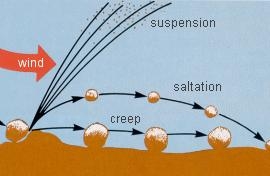
 The
Mesquite Flats Dune Field is easily accessible. There is a paved
parking area with spaces for large RVs and trailers and a set of
restrooms. The dunes start a short walk from the parking area. Once
on the dunes there are no specific trails.
The
Mesquite Flats Dune Field is easily accessible. There is a paved
parking area with spaces for large RVs and trailers and a set of
restrooms. The dunes start a short walk from the parking area. Once
on the dunes there are no specific trails.
As with all locations in National Parks, everything is
protected, so leave it as you found it.
This dune field is thought to be about 2,000 years old. It sits
on five to seven kilometers of alluvial fill, the thickest alluvial
fill in Death Valley. Dunes are classified by the different shapes
they make
(http://www3.interscience.wiley.com:8100/legacy/college/strahler/0471238007/animations/ch19_animations/animation4.html).
Each of these dune types is characteristic of the predominant
direction of the wind. The dunes in the Mesquite Flats Dune Field
are predominantly transverse dunes. These types of dunes form where
the wind typically comes from the same direction all the time.
 Eolean Transport
Eolean Transport
The sand of these dunes has been transported to this location by
the regional winds. Like water, wind transports grains by one of
three methods, suspension (picked up by the wind and carried along
with it), saltation (grains that are picked up, moved a short
distance then fall back down, bouncing), or impact creep (grains
that are nudged along by saltating grains) depending upon the speed
of the wind and the size of the grain. Only the smallest and thus
lightest grains can be suspended by air, while the heavier grains
either saltate or are moved by impact creep.
These processes can be seen in a video by Kansas State
University
(http://www.weru.ksu.edu/new_weru/multimedia/movies/dust003.mpg)
The moving sand quickly begins forming ridges. These ripples are
a few inches from ridge to ridge and less than an inch high. These
ridges form as grains saltate from one crest to the other. Finer
grains are eroded away from the ridges and are left in the
relatively protected troughs between the crests. This results in a
patter of larger grains on top of finer grains. This characteristic
distinguishes aeolian deposition from ripples deposited by water.
Over time the ripples migrate in the direction of the wind.
 The large dune forms as sand begins to accumulate
in larger ridges. The ripples and other particles move up the
windward side of the dune. When the sand builds up the top of the
dune too steeply, the ridge collapses. The angle that the sand
begins to slide is called the angle of repose. Over time this
process slowly migrates the dune in the direction of the wind.
The large dune forms as sand begins to accumulate
in larger ridges. The ripples and other particles move up the
windward side of the dune. When the sand builds up the top of the
dune too steeply, the ridge collapses. The angle that the sand
begins to slide is called the angle of repose. Over time this
process slowly migrates the dune in the direction of the wind.
The Source of the Sand
All this sand had to come from somewhere. It is likely that the
sand comes from the many alluvial fans of Death Valley. Death
Valley Wash is also in the path of the predominant wind flow and
likely contributes sand to the dune field.
Sand Composition
From a distance only the tall active dunes are easily identifiable
and appear made of one type of sand. Closer inspection reveals a
variety of minerals can be found in the dunes. The light colored
quartz and feldspar predominate. However, the wind patterns
concentrate darker heavier minerals near the surface of the dune
and ripple crests. These darker minerals are magnetite and
amphibole. You can use a magnet to easily pick up the small bits of
magnetite.
Logging requirements:
Send me a note with:
- The text "GC2VGA8 Mesquite Flats Dune Field" on the first
line
- The number (including non-cachers) and names of the geocachers
in your group.
- Based on the shape of the dunes, what direction does the wind
usually come from?
- What feature is downwind of the dune field that would slow the
wind to deposit sand here (think big)
- If you have a magnet, find some magnetite.
The following sources were used to generate this
cache:
- Spear, Steven G. Ph.D., 2009, Death Velley
Geology, A Field Guide and Virtual Tour of the Geology of Death
Valley National Park and Environs, California and Nevada, Last
Updated: August 25, 2009
http://www.palomar.edu/geology/DVWeb.htm
- USGS, Eolian Processes,
http://pubs.usgs.gov/gip/deserts/eolian/, Last modified
10/29/97
- Robert S. Anderson & Kirby L. Bunas Grain
size segregation and stratigraphy in aeolian ripples modeled with a
cellular automaton, Nature 365, 740 - 743 (21 October 1993);
doi:10.1038/365740a0
http://www.nature.com/nature/journal/v365/n6448/abs/365740a0.html
- Saltation (geology), Wikipedia,
http://en.wikipedia.org/wiki/Saltation_(geology), last modified on
9 April 2010 at 16:52
- Indiana University, Week 8 Deserts and Glaciers
http://www.indiana.edu/~g103/G103/Week8/week8.html